Is Solar Business Profitable in India? A Comprehensive Guide
The solar business in India presents a compelling investment opportunity, with the market projected to reach USD 1254 billion by 2033, growing at an impressive CAGR of 41.5% . With government backing, technological advancements, and declining costs, solar businesses are demonstrating strong profitability potential, particularly for those who understand the market dynamics and choose the right business model.
For aspiring entrepreneurs, the solar industry presents an exciting opportunity. But is it truly profitable in the Indian context? To answer this, we need to explore the landscape from multiple angles—market dynamics, cost structure, government incentives, and practical viability.
Key Takeaways
- India’s solar industry is poised for rapid growth, with strong government support and falling solar panel costs.
- Demand for solar power is increasing across residential, commercial, and industrial sectors, making it a promising market.
- Investment in solar businesses can lead to high returns, especially in solar power generation, manufacturing, and installation services.
- The market for solar-based products is also growing, providing opportunities in consumer goods like solar lanterns and water heaters.
The State of the Solar Market in India
India is one of the top five countries in the world in terms of solar power generation. By 2024, the country had installed more than 70 GW of solar capacity, aiming for 280 GW by 2030. This increase is driven by central and state government policies, climate change objectives and a sharp decrease in solar device prices.
The Growth of Solar Power in India
Solar energy has become one of the largest markets in India over the past decade, driven by government policy and growing consumer awareness. The growth of India’s solar capacity has been exponential and it has set itself a target of 500 GW of renewable energy by 2030. While its overall solar capacity crossed the 50 GW mark in 2020, making it the fourth-largest solar market in the world (according to the Ministry of New and Renewable Energy (MNRE)).
Is Solar Business Profitable in India?
To answer this question directly: Yes, solar business in India is profitable, but profitability depends on various factors such as the type of solar business, market conditions, investment size, and expertise.
The Growth Story
India’s commitment to sustainability, coupled with incentives and favorable policies, has created a conducive environment for solar businesses. Let’s break it down:
- Government Support and Policies
The Indian government has introduced several schemes, such as the National Solar Mission (NSM), which has set the stage for significant investments in the solar sector. The Solar Park Scheme and Solar Rooftop Scheme are particularly designed to help businesses set up and scale operations in the solar space. Additionally, India offers tax incentives and subsidies for solar power installations, further improving profitability margins. - Solar Market Demand
As power shortages continue to be a challenge in rural areas, the demand for decentralized solar power solutions is rising. Solar pumps, home solar installations, and solar-powered appliances are seeing growing demand. Furthermore, there’s an increasing push towards electric vehicles (EVs), which also use solar power to charge, adding an extra dimension of opportunity for solar energy companies. - Technological Advancements
The reduction in the cost of solar panels due to technological advancements, along with economies of scale, has made solar power an affordable solution for both commercial and residential consumers. This has resulted in wider adoption, which in turn benefits solar businesses.

Factors Contributing to Profitability
1. Government Incentives and Policies
The Indian government has been highly supportive of the renewable energy sector, particularly solar. Key incentives include:
- Capital Subsidy: Subsidies are available from the government for residential and commercial solar systems.
- Accelerated Depreciation: Tax laws provide accelerated depreciation benefits to establishments investing in solar power, providing faster returns on investment.
- GST Reduction: Another deciding factor in the increasing demand for solar panels is the reduced Goods and Services Tax (GST) for solar products.
2. Declining Solar Panel Costs
Solar panel prices have fallen more than 80% in the past decade. Even with this massive cost reduction of equipment, together with effective production, has made the solar business a lot more profitable. With solar panels being more affordable than ever, so has there been opportunities for businesses who are targeting both the residential and commercial markets.
3. Investment in Solar Infrastructure
With India taking an increasingly concentrated decision to develop solar parks and large-scale solar projects, companies are increasingly finding demands to supply, install and maintain solar systems. Megaprojects such as the Pavagada Solar Park in Karnataka (2,050 MW) and the Bhadla Solar Park in Rajasthan (2,245 MW) bode well for the companies talented enough to dig into the nuances of megaprojects.
4. Demand for Green Energy
The call for renewable energy, including solar, increases with so many sectors and individuals moving towards sustainability. This trend which is supported by global commitment with respect to carbon reduction and India’s declaration to cut down on its carbon intensity.
Profitability Analysis
Investment Returns and Metrics
| Metric | Description | Typical Range |
| ROI | Return on Investment | 300% over 25 years |
| Payback Period | Time to recover initial investment | 4-6 years |
| IRR | Internal Rate of Return | 15-20% |
| LCOE | Levelized Cost of Energy | Competitive with grid tariffs |
Business Models and Their Profitability
- CAPEX Model
- Upfront investment required
- Higher long-term returns
- Complete control over operations
- Eligible for tax benefits and accelerated depreciation
- OPEX/PPA Model
- Minimal upfront investment
- Steady revenue stream
- Lower maintenance responsibility
- Predictable returns
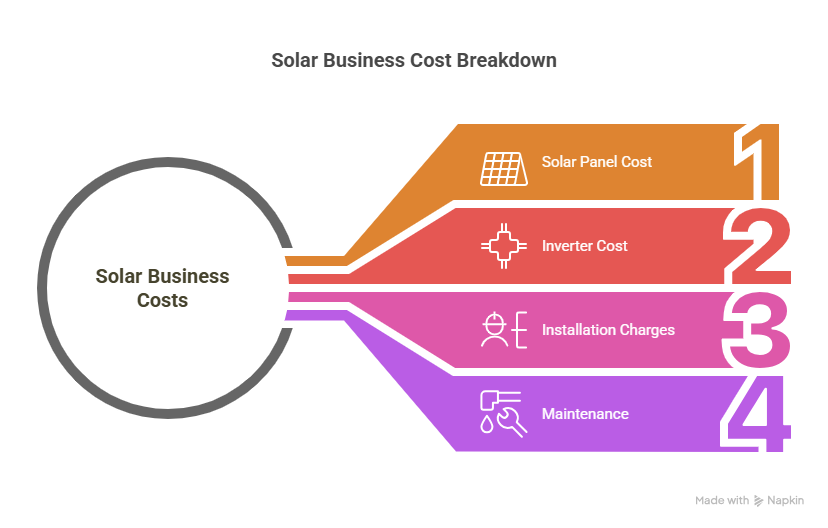
Cost Breakdown: Installation and Maintenance
Starting a solar business, whether as a service provider or as a plant owner, involves upfront investments. Here’s a quick breakdown:
- Solar Panel Cost: ~Rs. 20 to 30 per watt
- Inverter Cost: Rs. 10,000 to Rs. 50,000 depending on capacity
- Installation Charges: Rs. 5 to 10 per watt
- Maintenance: Low; usually Rs. 1,000–2,000 per kW/year
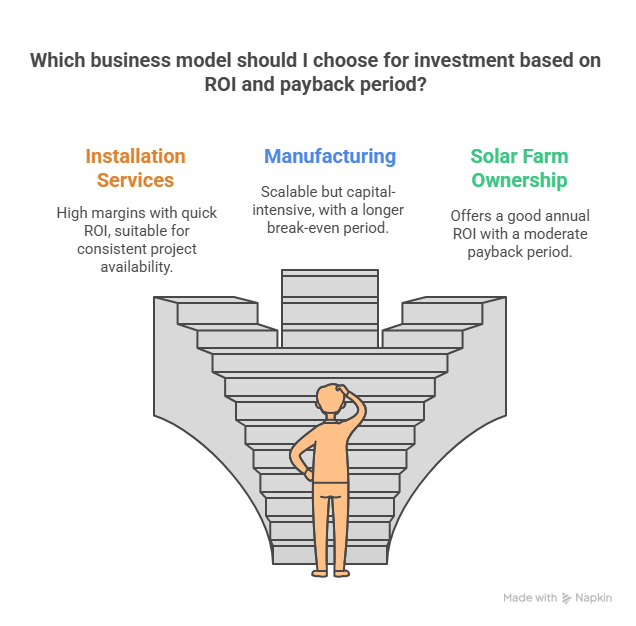
ROI for Different Business Models
- Installation Services: High margins due to labor and design expertise. ROI can be achieved in less than a year with consistent projects.
- Manufacturing: Capital-intensive but scalable. Break-even can take 3–5 years.
- Solar Farm Ownership: ROI ranges from 14% to 20% annually. Payback in 6–8 years.
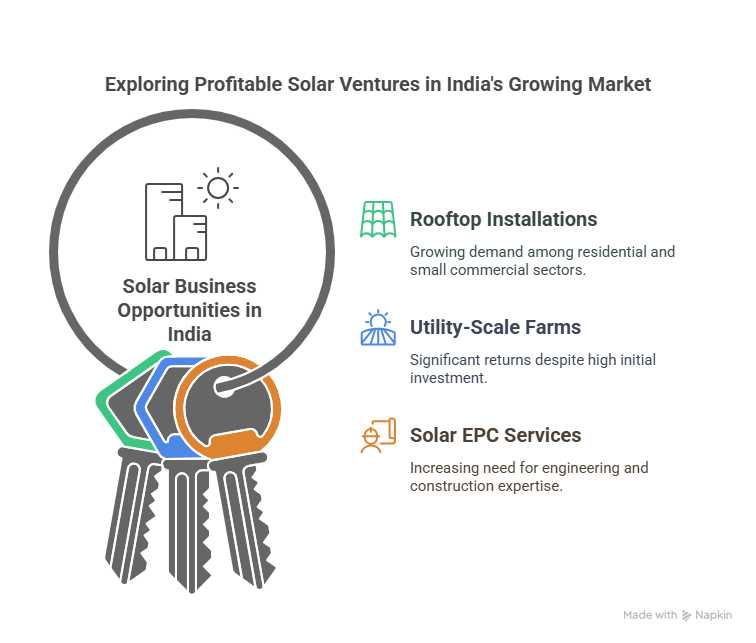
Solar Business Opportunities in India
Lucrative Segments
- Rooftop Solar Installations: Booming among residential societies, SMEs, and schools.
- Utility-Scale Solar Farms: High entry cost but significant returns through Power Purchase Agreements (PPAs).
- Solar EPC Services: Engineering, Procurement, and Construction services are in high demand.
Emerging Niches
- Agricultural Solar Pumps: Supported by PM-KUSUM, this is transforming irrigation across rural India.
- Solar-Powered Cold Storage and Street Lighting: Newer avenues with untapped market potential.
Challenges in the Solar Business
Despite its promise, the solar industry isn’t without hurdles:
- High Initial Investment: While ROI is strong, the upfront cost can be prohibitive without financing.
- Regulatory Complexity: Permits, DISCOM approvals, and compliance can be slow and complex.
- Skilled Manpower Shortage: There’s a lack of adequately trained technicians and installers.
- Land Acquisition: For large-scale projects, acquiring land with clear titles is a major obstacle.
- Price War: Intense competition among EPC companies leads to thin profit margins.
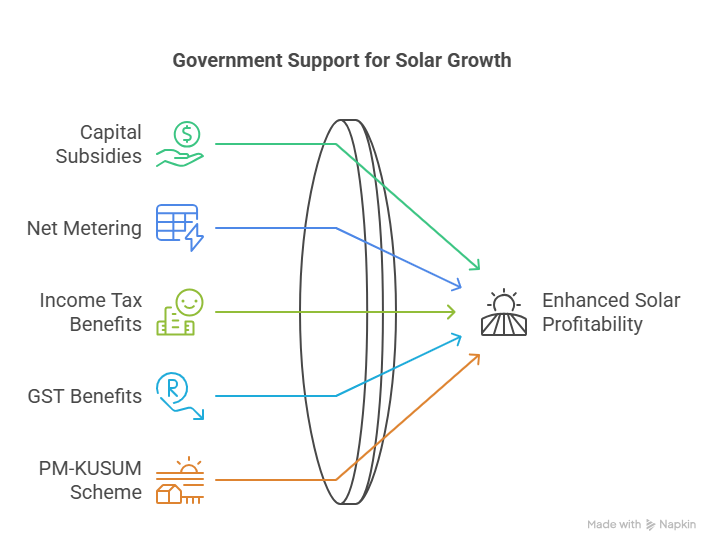
Government Policies Boosting Solar Profitability
The government continues to support solar ventures with robust policies:
- Capital Subsidies:
- Up to 40% subsidy for residential rooftop solar installations.
- Net Metering:
- Consumers can sell excess electricity back to the grid.
- Income Tax Benefits:
- Accelerated depreciation of up to 40% available on solar assets.
- GST Benefits:
- Reduced GST rate (5%) on solar modules and related equipment.
- PM-KUSUM Scheme:
- Financial assistance for solar pumps and off-grid solar systems in rural India.
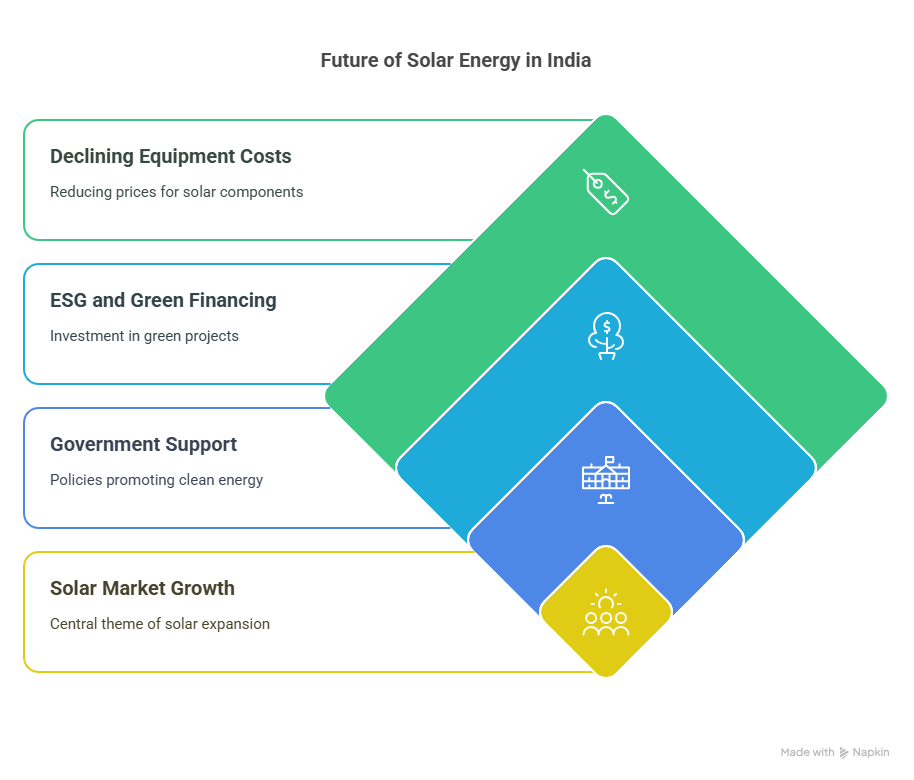
Future Outlook: Is the Sun Still Rising?
The solar market in India is poised for growth in the following ways:
- Technological Innovation:
- More efficient panels, smart grids and advances in battery storage.
- Declining Equipment Costs:
- The costs of modules, inverters and mounting structures are declining.
- ESG and Green Financing:
- Increased institutional investment in green energy projects.
- Government Support:
- Continued movement toward a clean tech and energy independence.
As grid electricity prices go up, solar land becomes not only a green choice but also a smart decision economically.
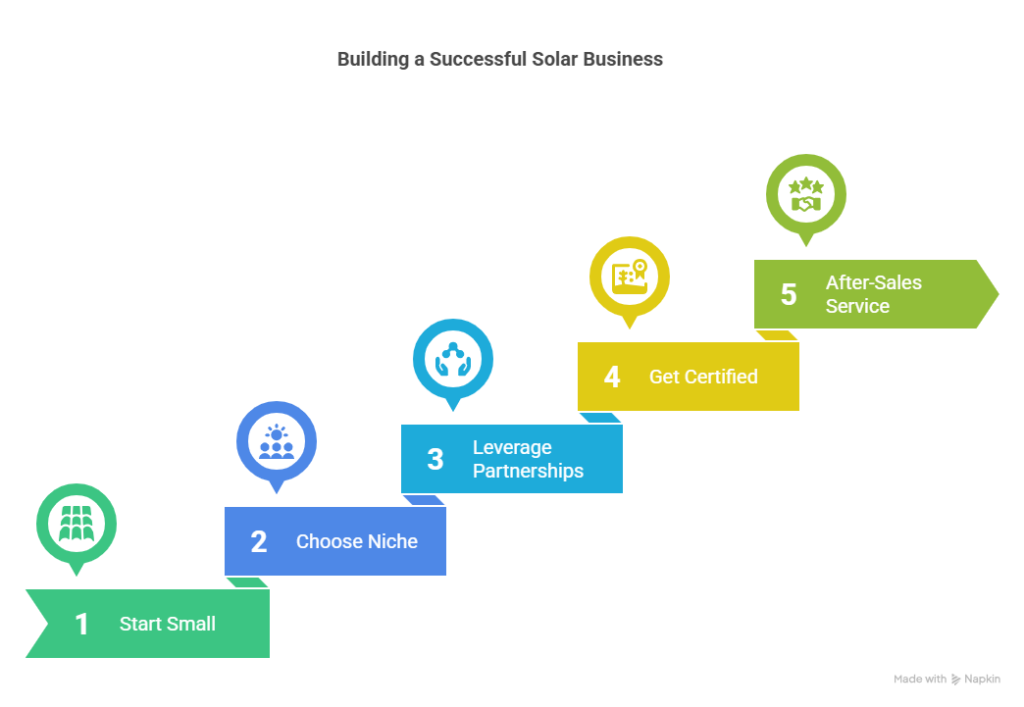
Actionable Tips for Entrepreneurs
- Start Small:
- Begin with local residential installations or a dealership model.
- Choose the Right Niche:
- Don’t try to do it all. Focus on one segment like rooftop, O&M, or agri-solar.
- Leverage Partnerships:
- Tie up with component manufacturers or financing companies.
- Get Certified:
- Enroll in MNRE-recognized training programs to gain technical credibility.
- Focus on After-Sales Service:
- Building trust and long-term relationships ensures referrals and repeat clients.
Solar Business Models in India: Which One is Profitable?
There are several business models in the solar sector, with different degrees of profitability:
- Solar Panel Manufacturing
Setting up solar panel manufacturing unit requires a lot of initial investment, but it is very lucrative business. Manufacturers have a real potential market due to the increase in demand for solar panels. - Solar Power Installation and Maintenance
Installation, maintenance, and repair services for solar panels are also enjoying steady growth. As the adoption of solar rose sharply, the segment continues to see strong demand especially in urban and semi-urban locations. - Solar Power Generation
For companies able to take a cost hit upfront, solar power generation provides a steady stream of income via power purchase agreements (PPAs) with utilities or large corporations. Government incentives and long-term contracts make solar parks especially attractive for investors. - Solar-Based Products
Offering solar-powered products such as solar lanterns, solar water heaters, and solar-powered home appliances has become a profitable venture. These products require lower capital investments and cater to both rural and urban markets.
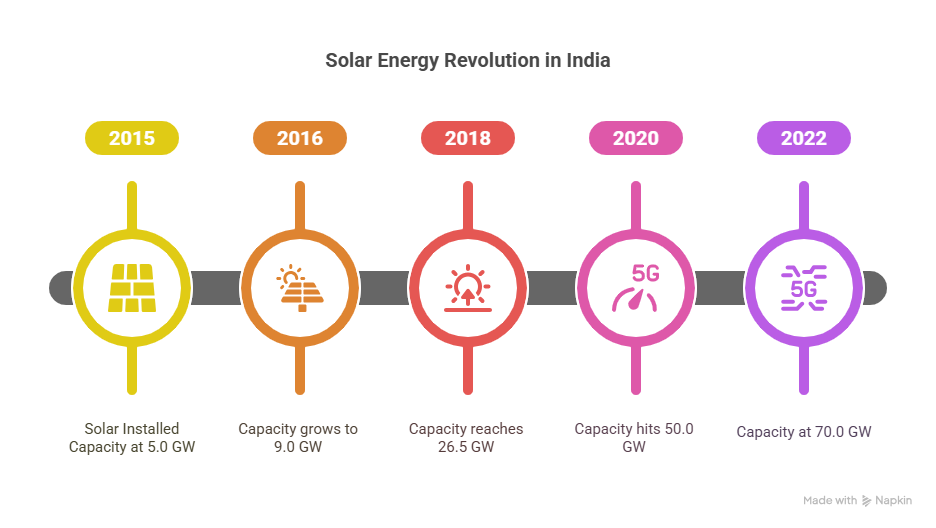
Solar Industry Statistics and Trends in India
| Year | Solar Installed Capacity (GW) | Solar Investment (INR) | Growth Rate |
|---|---|---|---|
| 2015 | 5.0 GW | 10,000 crores | 55% |
| 2016 | 9.0 GW | 15,000 crores | 80% |
| 2018 | 26.5 GW | 30,000 crores | 110% |
| 2020 | 50.0 GW | 60,000 crores | 150% |
| 2022 | 70.0 GW | 85,000 crores | 140% |
Final Thoughts
The solar business in India isn’t just about energy—it’s about economic empowerment, environmental stewardship, and building a future-ready enterprise. For those willing to invest in learning, relationships, and execution, solar isn’t just profitable. It’s transformational.
As the sun rises over the Indian economy, make sure your business rises with it.

Frequently Asked Questions (FAQs)
Q: What is the future of solar energy in India?
A: Solar energy will continue to grow, driven by government policies, global sustainability trends, and technological advancements. The Indian government’s target of 500 GW of renewable energy by 2030 makes it clear that solar energy will play a critical role in India’s energy future.
Q: How much does it cost to start a solar business in India?
A: The cost depends on the business model. A solar installation business might require an initial investment of ₹10-20 lakhs, while manufacturing units may require ₹1-2 crores or more.
Q: Are there risks involved in the solar business in India?
A: Yes, risks include fluctuating policies, market competition, and challenges in scaling up operations. However, these risks can be mitigated by understanding the market and aligning with government schemes.
Q: What are the top solar companies in India?
A: Some of the leading solar companies in India include Tata Power Solar, Adani Green Energy, and Vikram Solar.
Q: What is the minimum investment required to start a solar business in India?
A: The investment varies based on the business model, ranging from a few lakhs for distribution business to several crores for manufacturing.
Q: How long does it take to break even in the solar business?
A: Typically, the payback period ranges from 4-6 years, depending on the scale and business model.
Q: What government incentives are available for solar businesses?
Key incentives include accelerated depreciation, tax benefits, and capital subsidies for various segments.
Q: Which solar business model is most profitable?
A: The CAPEX model offers higher long-term returns, while the OPEX model provides steady revenue with lower initial investment.
Q: What are the main challenges in the solar business?
A: Primary challenges include high initial costs, technical issues like grid integration, and regulatory compliance requirements.
Q: Is solar business profitable in India?
A: Absolutely. With high demand, falling costs, and favorable policies, solar businesses enjoy steady ROI, especially in installation and EPC models.
Q: What is the cost of a 1-acre solar farm in India?
A: Roughly INR 3.5–4.5 crores for setting up a 1 MW solar plant (approx. 1 acre).
Q: What is the future of the solar business in India?
A: Very bright. Government targets and rising electricity costs ensure continued growth through 2030 and beyond.
Q: Is Tata Solar dealership profitable?
A: Yes. Tata Power Solar has a strong brand and demand. Profitability depends on local market, marketing efforts, and service quality.
Q: What are the franchise costs?
- Tata Solar: Around INR 5–10 lakhs+
- Adani Solar: Around INR 15–20 lakhs+
- APN Solar: INR 3–6 lakhs (low-investment model)



